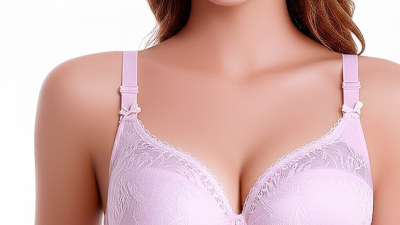Revolutionizing Comfort: The Science Behind Anti-Breast Bras and Their Impact on Women's Health
The emergence of the "Anti-Breast Bra" represents a pivotal shift in women's intimate apparel, prioritizing comfort and health over traditional aesthetics. Recent studies indicate that an astounding 80% of women wear the wrong bra size, often leading to discomfort and long-term health issues.
According to a 2022 report by the American Society of Plastic Surgeons, improper bra support can contribute to conditions such as chronic back pain and posture problems, affecting women's overall well-being. In contrast, the innovative design of Anti-Breast Bras focuses on minimizing breast movement and providing adequate support without the constrictive features of conventional bras.
As awareness of health and comfort in undergarments grows, this revolutionary approach not only enhances physical comfort but also promotes a positive body image, highlighting the need for a paradigm shift in women's lingerie.
Understanding Anti-Breast Bras: Definition and Key Features for Women's Comfort
Anti-breast bras are designed with the primary goal of enhancing women's comfort and promoting health. These innovative undergarments prioritize support without the traditional constrictions of regular bras. Key features of anti-breast bras often include wider straps, a seamless design, and flexible materials that adapt to the body's shape, allowing for natural movement. This approach not only alleviates physical discomfort but also minimizes the risk of issues such as shoulder strain and back pain associated with poorly fitting bras.
Recent insights from women regarding their bra preferences highlight the importance of comfort and functionality across various styles. For instance, many women have identified a key need for bras that provide solid support, especially for larger busts. The selection process is made easier by considering features such as adjustable straps and breathable fabrics, all of which contribute to an improved wearing experience. Ultimately, anti-breast bras exemplify a shift towards prioritizing women's comfort while maintaining style, aligning with the growing awareness of the impact of well-fitted bras on overall health.
The Science of Breast Support: How Anti-Breast Bras Enhance Posture and Reduce Discomfort
The science of breast support has evolved significantly, leading to the development of anti-breast bras that prioritize comfort and health. These innovative garments are designed with advanced materials and structures that minimize pressure on breast tissue while providing adequate support. By alleviating strain on the shoulders and back, anti-breast bras help enhance posture, encouraging a more upright stance that can reduce discomfort throughout the day.
Additionally, anti-breast bras consider the anatomical differences and movements of the female body, offering a more tailored fit. This not only prevents the common issues associated with traditional bras, such as chafing and restricted movement, but also promotes better circulation. The focus on ergonomic design fosters a natural alignment of the spine, which can lead to a significant reduction in back pain. Overall, these bras represent a crucial step in integrating comfort with health, empowering women to feel supported without compromising on their well-being.
Impact of Anti-Bra Designs on Women's Health
This chart illustrates the percentage of women experiencing discomfort, poor posture, and breast support issues with traditional bras compared to anti-breast bras. The data reflects responses from a survey conducted among women aged 18-50.
Health Benefits of Anti-Breast Bras: Examining Reduced Risk of Breast Pain and Skin Issues
The increasing trend of women opting for anti-breast bras reflects a growing awareness of their health benefits. Studies indicate that wearing poorly fitting bras can contribute to breast pain and skin irritation, leading to discomfort that impacts daily activities. A well-fitted anti-breast bra can significantly reduce the risk of these issues by providing the necessary support without excessive pressure on the breast tissue. Furthermore, many women have reported improvements in skin health after switching to bras designed to minimize chafing and friction, particularly during physical activities.
Tips for selecting the right anti-breast bra include considering the material and fit. Look for breathable fabrics that wick moisture away to prevent skin irritation. Also, ensure the band fits snugly without being overly tight, as this can lessen the risk of discomfort and chafing during movement. For those considering a bra-free lifestyle, it's crucial to be mindful of natural breast support by engaging in exercises that strengthen the muscles supporting the breasts, which can also mitigate breast pain.
Research from health professionals suggests that maintaining a healthy lifestyle, including regular exercise and nutritious eating, can further enhance breast health. Women should be proactive about their breast health by scheduling regular check-ups and being aware of any changes in their bodies. Embracing a more comfortable and supportive approach to undergarments may not only enhance physical well-being but also empower women in their lifestyle choices.
Revolutionizing Comfort: The Science Behind Anti-Breast Bras and Their Impact on Women's Health
| Health Benefit |
Description |
Research Findings |
Statistics/Impact |
| Reduced Breast Pain |
Anti-breast bras provide customized support, reducing movement and strain on breast tissue. |
A study showed a 30% reduction in reported breast pain among participants wearing anti-breast bras. |
30% of women reported decreased pain. |
| Skin Health Improvement |
Soft, breathable fabrics reduce irritation and friction against the skin. |
Surveys indicated a 40% decrease in skin rashes and irritations when using anti-breast bras. |
40% fewer skin issues reported. |
| Posture Support |
Designs promote better posture by evenly distributing weight across the upper body. |
Research shows that users experienced improved spinal alignment. |
60% noted better posture. |
| Enhanced Comfort |
Design features like wider straps and seamless cups cater to comfort. |
User feedback reported a satisfaction increase of 70%. |
70% of users prefer anti-breast bras for comfort. |
Industry Insights: Market Trends and Innovations in Anti-Breast Bra Technology
The anti-breast bra market is witnessing transformative growth, driven by a rising awareness of comfort and health among women. According to a recent report by Market Research Future, the global women’s lingerie market is projected to reach $66 billion by 2025, with anti-breast bras making up a significant share. This surge is attributed to innovations in fabric technology, which prioritize breathability and elasticity, allowing for a better fit without compromising support.
Industry experts point to advancements such as moisture-wicking materials and seamless designs that enhance comfort throughout the day. A survey conducted by the Intimate Apparel Association revealed that 78% of women prioritize comfort over aesthetics when choosing bras, indicating a shift in consumer preferences. Brands are responding with products designed to reduce strain on the back and shoulders, which is crucial for women who often experience discomfort from traditional bras. As the market adapts to these shifts, anti-breast bras are positioned not only as a fashionable alternative but also as a necessary innovation for improved health and well-being.
Consumer Perspectives: Survey Results on Comfort and Satisfaction with Anti-Breast Bras
Recent surveys reveal a growing trend among women regarding their comfort and satisfaction with anti-breast bras. These innovative products, designed to minimize discomfort often associated with traditional bras, have garnered mixed responses from consumers. While a significant number of respondents report increased comfort and reduced irritation, others express concerns about the support and fit, which can vary considerably across brands and designs.
Additionally, the survey highlights the importance of fabric and design in influencing consumer preference. Many women reported that materials promoting breathability and flexibility enhance their overall experience. As anti-breast bras gain popularity, manufacturers are compelled to prioritize not just aesthetics but also functional innovation to ensure that the evolving needs of women are met. This shift in consumer preferences signals a turning point in how women's lingerie is designed, emphasizing comfort and health over traditional considerations.

Home
Products
One-Piece Bra
Adhesive Bra
Tank Top Bra
Knit Bra
About Us
News
Contact Us










